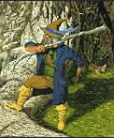“I would that we had … something of the same sort that belonged to the English.”
(Tolkien on his envy of the Finns and the ancient myths and ballads of the ‘Kalevala’)
Tolkien and Finnish
Introduced to Latin, French, and German by his mother, JRR Tolkien quickly became very fond of languages, especially the more ancient ones, such as Latin and Greek. His love for literature and mythology continually drove him to learn different ancient languages, especially so he could read the original versions of stories he had loved since his childhood – ‘Sigurd’ in Old Norse, ‘Beowulf’ in Anglo-Saxon, and ‘Sir Gawain and the Green Knight’ in Middle-English.
But it was during his time at Oxford University that Tolkien discovered a Finnish grammar in Exeter College Library, and was delighted by it. As he had done with other languages, Tolkien then taught himself Finnish, a language that became the inspiration for Quenya, the tongue of the High Elves. And through his studies, the ‘Kalevala’ in its original Finnish came to his hands.
Kalevala and Finland national epic
Finnish mythology, in the form of songs and tales, was transmitted orally from generation to generation, from parents to children. But because of this strong oral tradition, until relatively recently there wasn’t anything written or published that compiled the whole richness of the country’s history.
It was the Finnish country doctor Elias Lönnrot who decided to travel around Finland in the early 19th century, listening to anyone that had some tale or song to sing about the mythology of Finland, gathering it all together, and putting it down in writing. Those songs and verses, called ‘runots’, ordered by Lönnrot, formed the original version of the ‘Kalevala’ which was first published in 1835 with approximately twelve thousand verses. The collection was an amazing success and Lönnrot, cheered to see his efforts well appreciated, kept investigating and 14 years later, the definitive edition of the ‘Kalevala’ was published, this time with 22,800 runots, double the length of the first one.
Known as the ‘Finnish National Epic’ since its publication, the ‘Kalevala’ gave Finland a feeling of entity and nation. The legends and poems of its culture and religion had finally been compiled, preserving the country’s history and language, both of which eventually could have faded.
The origins of the poetry collected in ‘Kalevala’ date back as far as 2,500 – 3,000 years ago, when a form of song characterised by alliteration and parallelism was common. However, the ‘Kalevala’ songs do not come from just a single period of history, but from several. The people who sang them were known as rune singers.
Kalevala and Tolkien
As Finnish influenced Quenya, some of the myths we find as we read the ‘Kalevala’ influenced Tolkien’s ‘The Lord of the Rings’.
– One of the main similarities between the two books is the appearance of Nature as a great force in the story. In ‘Kalevala’, Nature is carefully described, and is always present in the characters’ journeys in the same way that Nature is present in the Fellowship’s journey. So important is Nature in ‘Kalevala’ that we can say it has ‘own life’, and we can see that the Sun, rivers and trees speak clearly to the inhabitants of the country. They give advice and warnings, and have their own strong feelings, as, for example, we can learn from a birch who cries to be alone waiting for its destruction, which will inevitably come from men’s hands. We can’t help but compare this birch not just to the Ents because of the fact that they are talking trees, but to the whole of nature in Middle-earth that is fading because of war and evil.
– The title Kalevala, meaning ‘ The Land of the Heroes’, refers to Finland, a country fairly described as a wonderful dwelling, full of Nature and good things, and a place that finds its darker side in Pohjola, described as a dark cold place, ruled by an old witch. We can compare these with some fair and foul places in Middle-earth like The Shire and Mordor.
– The main character is ‘Kalevala’ is Väinämöinen, a wise old hero who above all wants the best for his native land and who will give everything to protect it. He is very learned in lore, poetry and music, and his magic and power are based in his words. In ‘The Lord of the Rings’, we find a parallel figure in Gandalf, the wise wizard who could even defeat an ancient evil with the power of his words, recalling his fight against the Balrog of Morgoth in Moria. Both Väinämöinen and Gandalf are confident leaders and though they can fight when there is need, their strongest power resides in words and lore.
– Another important similarity among these works is the presence of an immensely powerful object. The One Ring in ‘The Lord of the Rings’ finds its double in the Sampo of ‘Kalevala’, an object forged to give prosperity and richness to its master. It is given to the old witch of Pohjola in payment of a debt, but eventually ends up being stolen, smashed and lost in the sea, though only after causing great trouble.
– Finally, these two pieces of literature share a common ‘message’, emphasising loyalty, friendship, sacrifice and the eternal fight of good against evil.









